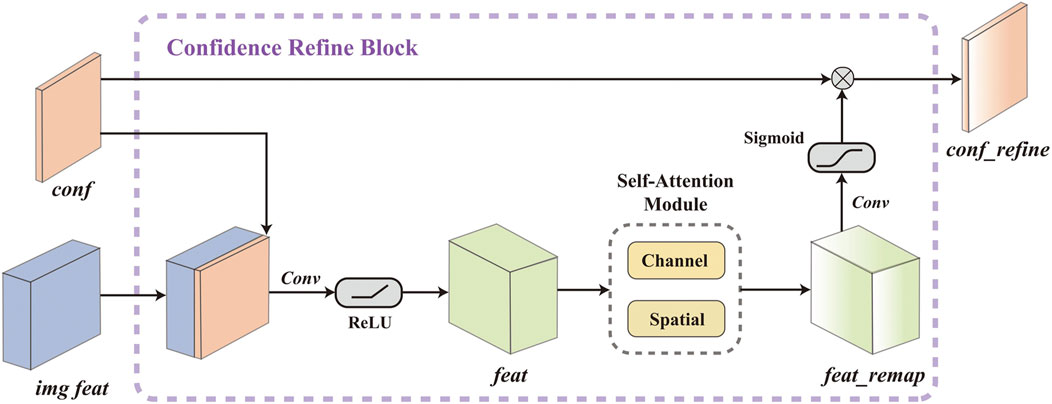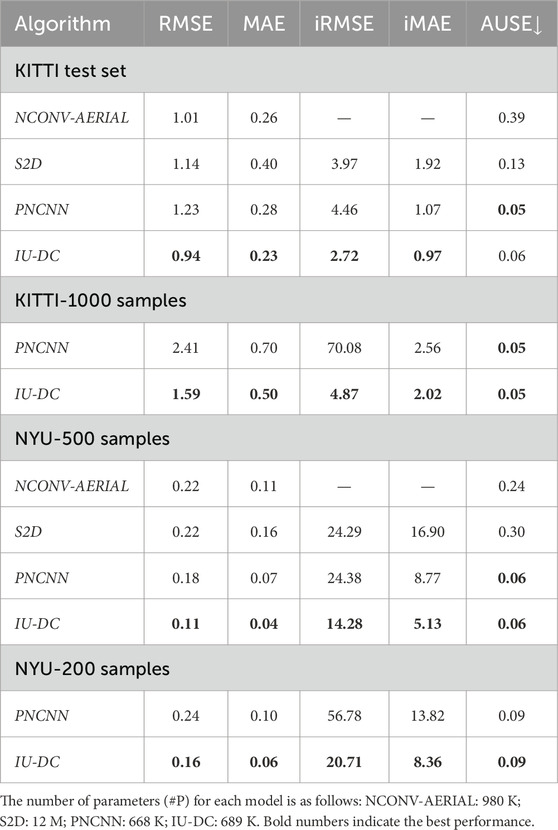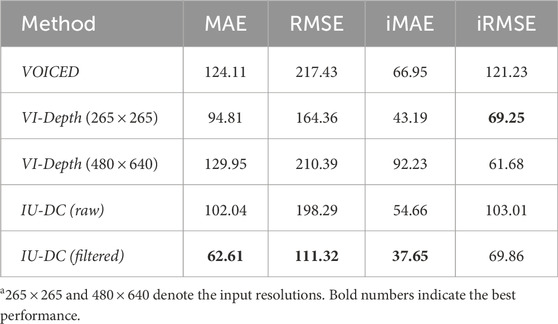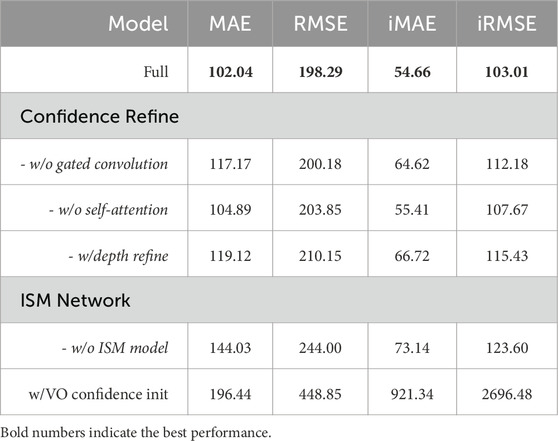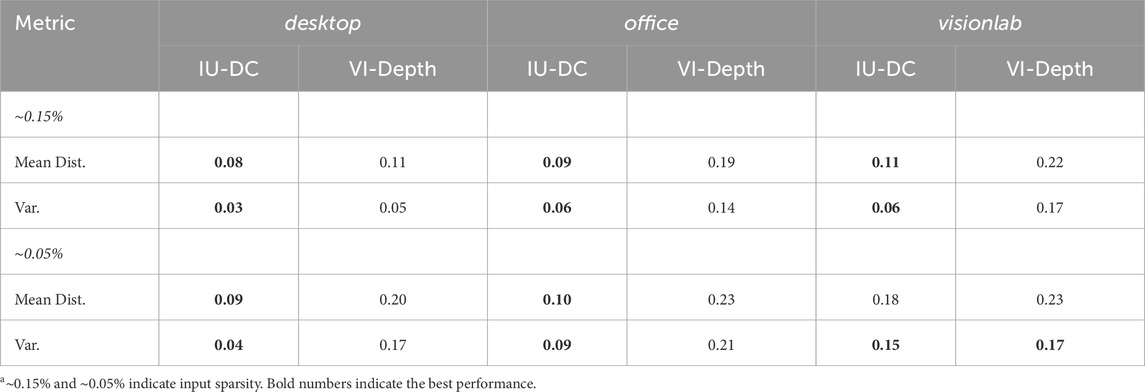- School of Mechanical Engineering and Automation, Beihang University, Beijing, China
Introduction: Visual odometry (VO) has been widely deployed on mobile robots for spatial perception. State-of-the-art VO offers robust localization, the maps it generates are often too sparse for downstream tasks due to insufffcient depth data. While depth completion methods can estimate dense depth from sparse data, the extreme sparsity and highly uneven distribution of depth signals in VO (∼ 0.15% of the pixels in the depth image available) poses signiffcant challenges.
Methods: To address this issue, we propose a lightweight Image-Guided Uncertainty-Aware Depth Completion Network (IU-DC) for completing sparse depth from VO. This network integrates color and spatial information into a normalized convolutional neural network to tackle the sparsity issue and simultaneously outputs dense depth and associated uncertainty. The estimated depth is uncertainty-aware, allowing for the filtering of outliers and ensuring precise spatial perception.
Results: The superior performance of IU-DC compared to SOTA is validated across multiple open-source datasets in terms of depth and uncertainty estimation accuracy. In real-world mapping tasks, by integrating IU-DC with the mapping module, we achieve 50 × more reconstructed volumes and 78% coverage of the ground truth with twice the accuracy compared to SOTA, despite having only 0.6 M parameters (just 3% of the size of the SOTA).
Discussion: Our code will be released at https://github.com/YangDL-BEIHANG/Dense-mapping-from-sparse-visual-odometry/tree/d5a11b4403b5ac2e9e0c3644b14b9711c2748bf9.
1 Introduction
Constructing a detailed and accurate map of the environment is a core task in the spatial perception of mobile robots (Malakouti-Khah et al., 2024). Visual odometry (VO) is widely used on mobile robots for perception due to its computational efficiency and adaptability to various environments (Labbé and Michaud, 2022; Aguiar et al., 2022). While state-of-the-art VO provides accurate localization, the resulting sparse depth data often leads to incomplete maps with insufficient spatial information, posing challenges for downstream tasks (Araya-Martinez et al., 2025). With breakthroughs in the computer vision community, sparse depth data can be completed using depth completion approaches (Mathew et al., 2023; Wan et al., 2025), offering a pathway to achieving dense maps in VO. However, the extreme sparsity of depth in VO can only offer limited prior knowledge and still poses significant challenges for depth completion approaches to estimate accurate dense depth for mapping.
Recent developments in depth completion approaches have achieved high accuracy on datasets even with limited input data through carefully designed feature extraction mechanisms and sophisticated network architectures (Chen et al., 2023; Liu et al., 2023; Liu et al., 2022). However, the computational load and memory requirements hinder their practical implementation on mobile robots with limited memory capacity. Additionally, even approaches with high accuracy on datasets still produce a non-negligible number of outliers during inference, leading to false mapping of the environment for robots (Tao et al., 2022). Several previous works have attempted to estimate both dense depth and associated uncertainty within a lightweight network architecture, using the uncertainty to reevaluate depth estimation (Tao et al., 2022; Ma and Karaman, 2018). These works have demonstrated real-world applications in reconstruction, motion planning, and localization. However, most of these works primarily consider inputs from LIDAR or incomplete depth images from depth cameras, which tend to exhibit lower sparsity and a more uniform distribution compared to data obtained from VO.
Following this method, we propose a novel depth completion network inspired by the normalized convolutional neural network (NCNN) (Eldesokey et al., 2019) to complete the extremely sparse depth data from VO. The pipeline of our method is presented in Figure 1. We name our approach Image-Guided Uncertainty-Aware Depth Completion Network (IU-DC). Our contributions can be summarized as.
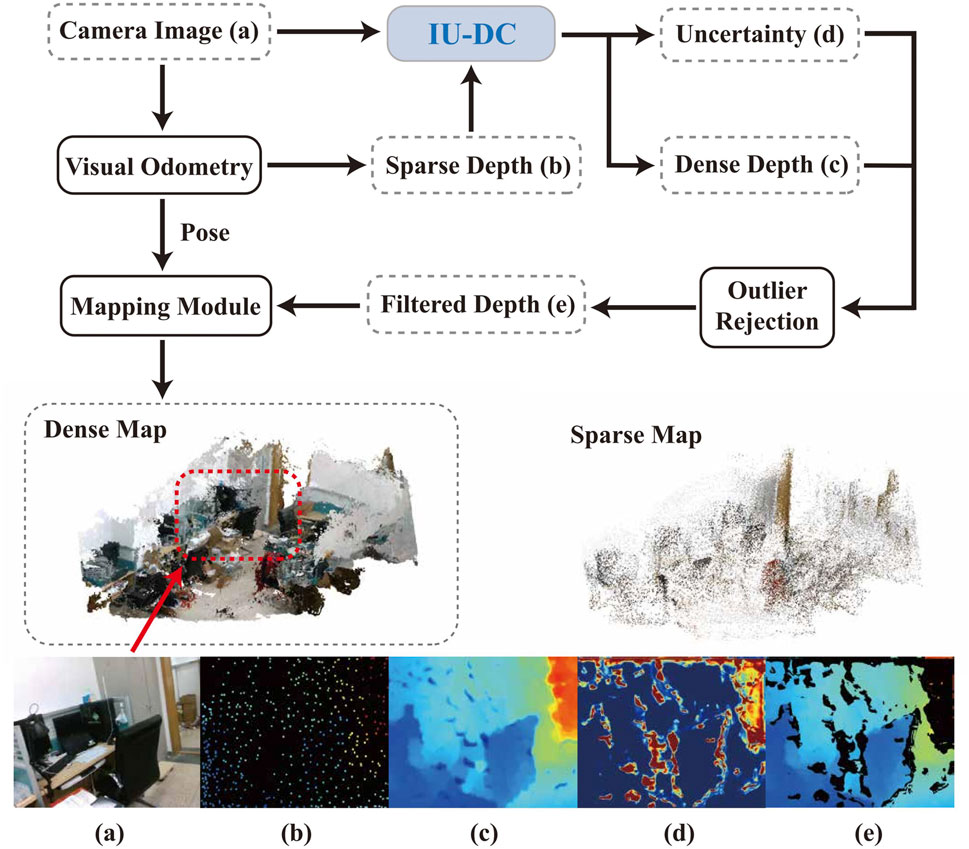
Figure 1. Pipeline of robot mapping with our approach. A dense map of the environment is constructed using only camera images and extremely sparse depth from VO with the proposed IU-DC. (a) RGB frame from the camera; (b) sparse depth from visual odometry; (c,d) dense depth and the associated uncertainty estimated by our network; (e) filtered depth obtained using the predicted uncertainty.
2 Related work
2.1 Depth completion with uncertainty awareness
We first briefly review recent developments in depth completion approaches that address both depth and uncertainty estimation. A widely adopted approach involves introducing a second decoder to the original network to output uncertainty. Popović et al. (2021) and Tao et al. (2022) both employed dual decoders to output depth estimation and uncertainty, demonstrating applications in robot mapping and path planning. However, their input sparsity is much lower than that of VO. Qu et al. (2021) introduced a Bayesian Deep Basis Fitting approach that can be concatenated with a base model to generate high-quality uncertainty, even with sparse or no depth input. However, its performance is highly dependent on the base model, making it difficult to achieve in a lightweight network architecture. Additionally, approaches such as ensembling and MC-dropout can estimate uncertainty without modifying the original network (Gustafsson et al., 2020). However, these methods involve a time-consuming inference process, which hinders real-time performance on robots.
Another promising approach is based on the theory of confidence-equipped signals in normalized convolution. Eldesokey et al. (2019) proposed a normalized convolutional neural network (NCNN) that generates continuous confidence maps for depth completion using limited network parameters. They further refined their work to obtain a probabilistic version of NCNN in (Eldesokey et al., 2020). Though the NCNN demonstrates outstanding performance in both depth completion and uncertainty estimation, it can only be used in an unguided manner due to algebraic constraints. This limitation results in performance degradation when the input has high sparsity due to a lack of prior information (Hu et al., 2022). Teixeira et al. (2020) attempted to extend NCNN into an image-guided method by concatenating the image with the outputs from NCNN into another network to generate the final prediction. While this approach improved depth completion accuracy, the resulting uncertainty lacked the continuity inherently modeled by NCNN. In this work, our proposed IU-DC extends NCNN into an image-guided approach to address the sparsity issue while maintaining inherent continuity to generate precise uncertainty estimation.
2.2 Depth completion from sparse VO
Several recent works have addressed the challenge of completing sparse depth from VO (Liu et al., 2022) (Wong et al., 2020; Merrill et al., 2021; Wofk et al., 2023). Wong et al. (2020) adopted an unsupervised approach, utilizing a predictive cross-modal criterion to train a network for inferring dense depth. Liu et al. (2022) adopted an adaptive knowledge distillation approach that allows the student model to leverage a blind ensemble of teacher models for depth prediction. Wofk et al. (2023) performed global scale and shift alignment with respect to sparse metric depth, followed by learning-based dense alignment, achieving state-of-the-art performance in depth completion accuracy. Although the sparsity issue of VO has been addressed in depth completion processes, few works are uncertainty-aware and demonstrate evaluations in mapping tasks.
3 Methodology
3.1 Overall network architecture
Our network mainly comprises three main modules: the Input Confidence Estimation Network, which takes camera images and sparse depth as input and estimates the confidence mask input to first NCNN layer; the Image-Guided Normalized Convolutional Neural Network, which uses NCNN as backbone and refines the confidence output from NCNN layers at different resolutions with image features using the proposed Confidence Refine Block; and the Model-based Uncertainty Estimation Network, which takes the estimated depth and confidence output from last NCNN layer to estimates the final output uncertainty for each data. The overall architecture of our network is presented in Figure 2, and the details of each module are explained in the following sections.

Figure 2. An overview of the proposed IU-DC. (1) Input Confidence Estimation Network, (2) Model-Based Uncertainty Estimation Network. The middle section with the Confidence Refine Block (Conf. Refine Block) represents the Image-Guided Normalized Convolutional Neural Network.
3.2 Input confidence estimation network
In Eldesokey et al. (2020), the initial confidence mask input into NCNN is learned from the sparse depth using a compact network. However, when the input data becomes sparser and more randomly distributed, confidence estimation may degrade because structure information, such as neighboring objects and sharp edges, is significantly missing (Hu et al., 2022). Sparse depth from VO is always calculated through the KLT sparse optical flow algorithm using corner features (Qin et al., 2018), which have a close correlation with the camera image. To compensate for the missing cues, we utilize both the image and sparse depth together to estimate the input confidence. In the Input Confidence Estimation Network, the image and sparse depth are first concatenated and then input into a compact UNet (Ronnebe et al., 2015) with a Softplus activation at the final layer to generate positive confidence estimations.
3.3 Image-guided normalized convolutional neural network
The motivation for adopting NCNN as our backbone lies in its inherent ability to explicitly model confidence propagation. Unlike conventional convolutional networks, NCNN operates on confidence-equipped signals and interpolates missing values in a mathematically principled manner. This capability is particularly valuable under extreme sparsity, such as in VO-derived depth inputs, where the lack of priors makes robust estimation difficult. Moreover, NCNN naturally facilitates uncertainty estimation through confidence propagation, which aligns well with our objective of producing uncertainty-aware depth maps.
Prior studies have shown that image features—especially in regions such as reflective surfaces and occlusion boundaries—often carry rich structural cues that can complement sparse or unreliable depth information (Kendall and Gal, 2017). These features serve as valuable priors for improving confidence estimation, particularly in scenarios where the input depth is extremely sparse and unevenly distributed, as in VO-based depth completion.
However, directly incorporating image features into NCNN is not straightforward. This is because normalized convolution enforces algebraic constraints that require a strict correspondence between the input signal and its associated confidence. Consequently, common practices in image-guided depth completion—such as concatenating image features with the depth signal (Tao et al., 2022; Popović et al., 2021; Eldesokey et al., 2019)—would violate these constraints and compromise the formulation of NCNN.
To leverage this potential without violating NCNN’s constraints, we propose the Confidence Refine Block (CRB). The primary motivation behind CRB is to introduce image guidance indirectly, by refining the intermediate confidence maps produced by NCNN layers. Rather than altering the depth signal directly, CRB enhances the confidence propagation process using gated fusion mechanisms and attention-based refinement. This design preserves the integrity of normalized convolution while effectively injecting contextual priors from the image, leading to improved performance under extreme sparsity.
In this section, we first review the basic concepts of the NCNN, and then introduce the details of how the proposed CRB fits into NCNN.
3.3.1 Normalized convolutional neural network
The fundamental idea of the normalized convolution is to project the confidence-equipped signal
Finally, the WLS solution
Instead of manually choosing the applicability function, the optimal
where
where the output from one layer is the input to the next layer. If the image feature is directly concatenated with the depth signal
3.3.2 Confidence refine block
We attempt to utilize the image features to refine, but not entirely alter, the confidence from the NCNN layers, as this would severely violate the correspondence between confidence and signals. Since sparse depth from VO is primarily concentrated in high-texture areas (e.g., object contours) while being sparsely distributed in low-texture regions (e.g., flat walls), this disparity leads to varying contributions of image features to confidence estimation across different areas. Given these challenges, a vanilla convolution (a standard convolution operation with normalization and an activation function) that treats all inputs as valid values is not suitable.
Gated Convolution (Yu et al., 2019), which uses additional convolution kernels to generate gating masks for adaptive feature reweighting, is well-suited to our case. We modified the original form of gated convolution, which originally takes only one feature as input, to simultaneously consider both confidence and image features when calculating the gating signal, as shown in Figure 3. Although sophisticated modality fusion techniques have been proposed in recent years and can be adopted to fuse confidence features with image features (Liu et al., 2023), these methods often rely on complex convolution operations, which increase model complexity and go against our lightweight design. To address this issue, we adopt a straightforward yet effective strategy: first concatenating the two feature maps and encoding them with a lightweight convolution layer, then refining the fused representation using an efficient Self-Attention Module.
Denoting the confidence from NCNN layer as
however,
where
In IU-DC, we integrate one CRB after each confidence-aware down-sampling layer in the NCNN to learn the correlation between confidence and image at different resolutions, as shown in the upper section of Figure 2. We also provide a visualization of the gating signals
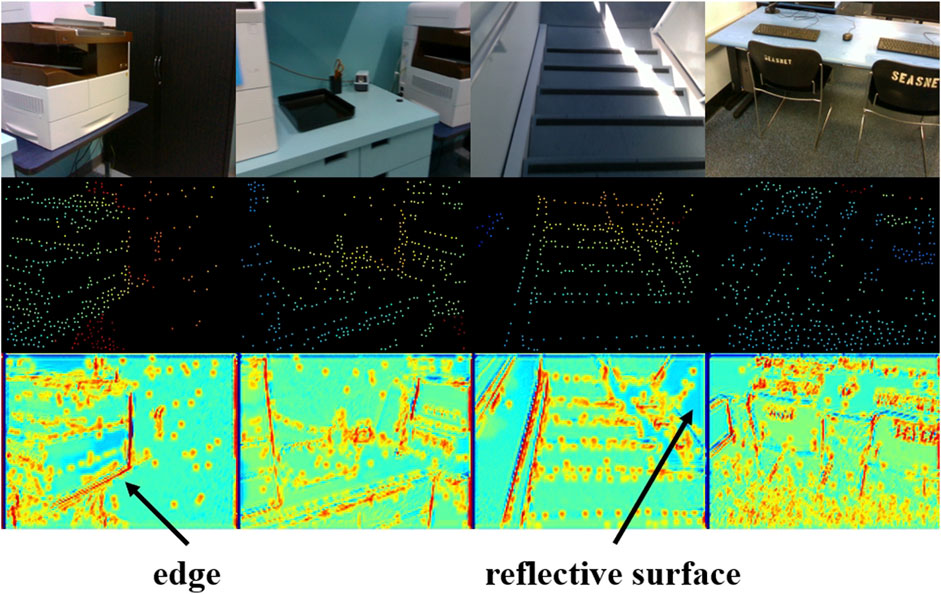
Figure 4. Visualization of the gating signal in the Confidence Refine Block. The first row presents the input image, the second row presents the input sparse depth from VO, and the third shows the corresponding gating signal.
3.4 Model-based uncertainty estimation network
In NCNN, the confidence is propagated separately from the depth signal as shown in (Equation 3), which results in a lack of spatial information. For instance, neighbors estimated from larger depth values typically have higher uncertainty compared to those from smaller depth values, which cannot be distinguished by normalized convolution due to the fixed size of the applicability function
To address this limitation, we assume that the dense depth output from NCNN forms an occupancy map in the camera frame and follows the probabilistic formulation of the Inverse Sensor Model (ISM) (Agha-Mohammadi et al., 2019). We integrate the confidence output from NCNN as a prior into this ISM-based probability model, thereby enabling the estimation of spatially-aware uncertainty. Furthermore, the entire module can be smoothly trained in an end-to-end manner using the loss function proposed in Section 3.5.
The probability distribution of individual voxel
where
which indicates the occupancy probability given a single measurement, into (Equation 4), and assuming that the robot’s previous trajectory
Assuming a binary occupancy model for voxels (i.e., each voxel is either occupied
where
where
Typically, a fixed
where
where
where
Our objective is to learn the mapping function
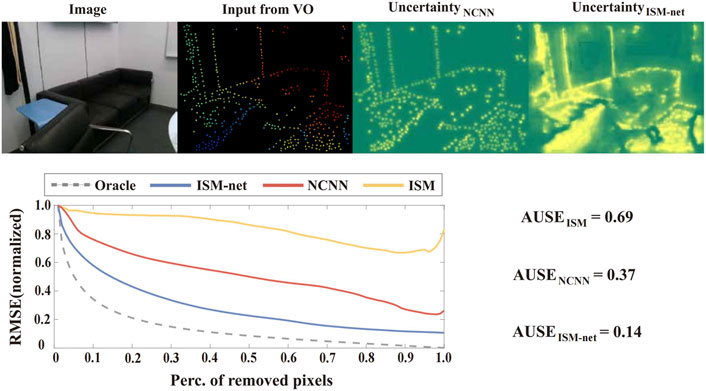
Figure 5. Qualitative and quantitative evaluation of the effectiveness of the Model-based Uncertainty Estimation Network. The upper part of the figure presents the input image, sparse depth from VO, uncertainty estimation from the last NCNN layer, and the final uncertainty estimation from our network (ISM-net). The lower part of the figure illustrates the area under the sparsification error plots (Ilg et al., 2018), where curves closer to the oracle represent estimated uncertainty that more closely approximates the real error distribution. ISM-net significantly enhances the uncertainty estimation from NCNN and outperforms the ISM by a large margin.
3.5 Loss function and training strategy
To achieve the different functions of each module, we require a loss function that enables training the proposed network with uncertainty awareness. Following (Eldesokey et al., 2020) we assume a univariate distribution of each estimated signal under naïve basis
where
During the training of our network, we find that initializing the network parameters randomly and training with the loss function
4 Evaluation on NYU and KITTI datasets
We use the standard error metrics of the KITTI depth completion challenge (Uhrig et al., 2017): the Root Mean Square Error (RMSE m), the Mean Absolute Error (MAE m), the Root Mean Squared Error of the Inverse depth (iRMSE 1/km), Mean Absolute Error of the Inverse depth (iMAE 1/km), and the area under sparsification error plots (AUSE) (Ilg et al., 2018) as measure for the accuracy of the uncertainty.
4.1 Datasets and setup
Outdoor: KITTI dataset (Uhrig et al., 2017) is a large outdoor autonomous driving dataset. We use KITTI depth completion dataset for evaluation, where the training set contains 86k frames, validation set contains 7k frames, and the test set contains 1k frames. The original input depth images have 5% of the pixels available. To simulate the input sparsity of VO, we randomly sample 1k pixels from the raw input depth image, representing approximately 0.2% of the pixels available.
Indoor: NYU dataset (Silberman et al., 2012) is an RGB-D dataset for indoor scenes, captured with a Micrasoft Kinect. We use the official split with roughly 48k RGB-D pairs for training and 654 pairs for testing. We randomly sample 500 pixels and 200 pixels from the ground truth depth image, representing available pixels of 0.7% and 0.2%, respectively.
Setup: We implement all the networks in PyTorch and train them using the Adam optimizer with an initial learning rate of 0.001 that is decayed with a factor of
4.2 Comparison to the SOTA
Baselines: We propose to obtain dense depth and uncertainty simultaneously, while also considering a lightweight network architecture with low memory consumption suitable for deployment on mobile robots. As baselines, we selected three state-of-the-art networks that meet the requirements: (i) NCONV-AERIAL (Teixeira et al., 2020) is an image guided approach that incorporates NCNN and fuses its output with images to estimate the final depth and uncertainty. (ii) S2D (Tao et al., 2022) is an image-guided approach that concatenates the image and sparse depth image in one encoder and outputs dense depth image and uncertainty from two separate decoders. (iii) PNCNN (Eldesokey et al., 2020) is an unguided approach that also utilizes NCNN as its backbone and has a network structure similar to our approach. We train PNCNN using their open-source code. For S2D, we follow their implementation as described in their paper since they did not release their code. As for NCONV-AERIAL, we use the best results reported in their paper and calculate AUSE using their open-source model.
We initially test all the methods on the KITTI test set with raw input sparsity and the NYU test set with 500 samples as input. We report the accuracy of depth and uncertainty estimation, as well as the number of network parameters in Table 1. S2D and NCONV-AERIAL demonstrate superior accuracy in depth completion compared to PNCNN on the KITTI, attributed to their integration of image features. However, on the NYU dataset where the input sparsity increases to
To simulate the input data from VO with a sparsity of approximately 0.2%, we further test IU-DC and PNCNN on the KITTI dataset with 1,000 samples and the NYU dataset with 200 samples. The iRMSE of PNCNN significantly degraded, being up to 15 times greater than IU-DC in KITTI, indicating the presence of a large number of outliers. This result suggests that when the sparsity becomes extremely high, the neighborhood of the signal cannot be correctly estimated due to the limited receptive field when depth data is the only input source. In contrast, IU-DC achieves robust performance even with this extreme sparsity of input by enriching information around the signal through the integration of image features. This makes IU-DC more suitable for deployment in VO scenarios. To qualitatively observe the results, we present the depth maps estimated from PNCNN and IU-DC on the KITTI dataset in Figure 6. IU-DC captures clearer edges and more detailed contours even when the input sparsity increases significantly.
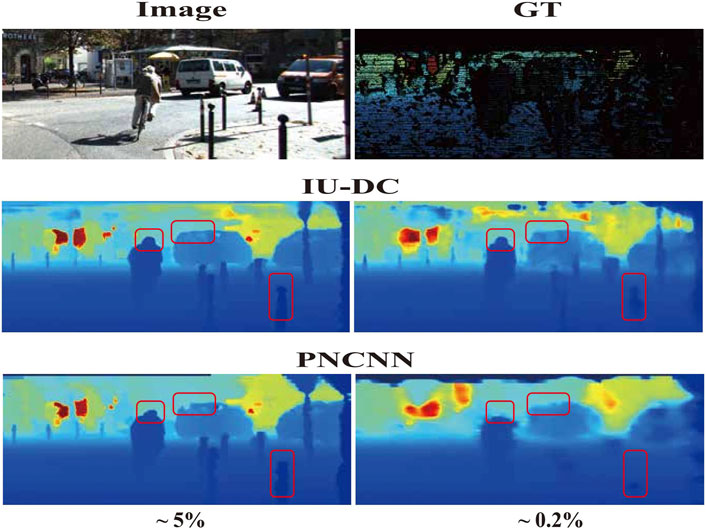
Figure 6. Visualization of depth completion results on the KITTI dataset, where
5 Dense mapping from sparse visual odometry
While Section 4 presents evaluations on standard benchmark datasets using synthetically downsampled sparse inputs, in this section we further evaluate IU-DC in real-world visual odometry (VO) scenarios, where the input sparsity and distribution better reflect robot deployment conditions. We additionally assess the impact of uncertainty-aware depth completion on mapping performance.
5.1 Evaluation with VO input
5.1.1 Dataset
VOID (Wong et al., 2020) provides real-world data collected using an Intel RealSense D435i camera and the VIO frontend (Fei et al., 2019), where metric pose and structure estimation are performed in a gravity-aligned and scaled reference frame using an inertial measurement unit (IMU). The dataset is more realistic in that no sensor measures depth at random locations. VOID contains
5.1.2 Comparison to the SOTA
As baselines, we select two methods that are designed to complete sparse depth from VO, similar to ours but without uncertainty estimation: (i) VOICED (Wong et al., 2020) is an unsupervised method that is among the first to tackle input from VO. (ii) VI-Depth (Wofk et al., 2023) integrates monocular depth estimation with VO to produce dense depth estimates with metric scale. Note that the open-source VI-Depth model was trained with a resolution of
5.1.3 Runtime analysis and memory consumption
Runtime and memory consumption are both crucial for deployment on mobile robots to achieve real-time performance. IU-DC exhibits significantly lower parameter counts
5.2 Ablation study
5.2.1 Effect of confidence refine
We first analyze the effect of our proposed Confidence Refinement Block (CRB) by introducing three baselines: (i) integrating image features using vanilla convolution instead of gated convolution (-w/o gated convolution); (ii) employing gated convolution without the self-attention module (-w/o self-attention); and (iii) using image features to refine the depth signal instead of confidence (-w/depth refine). The results are presented in Table 3. Our full model outperforms all baselines across all evaluation metrics, validating that gated convolution extracts more reliable features than vanilla convolution, thereby leading to improved accuracy in depth completion. Furthermore, integrating the self-attention module further enhances performance. We also find that removing the self-attention module in CRB significantly deteriorates the accuracy of uncertainty estimation, increasing the AUSE from 0.14 to 0.49. Moreover, refining confidence yields better results than the depth signal, highlighting the strong correlation between confidence in NCNN layers and images, which supports our motivation for designing CRB.
We further assess whether the multi-resolution integration of CRBs benefits the depth completion process and uncertainty estimation. The results are shown in Figure 7. The major difference between VOID and NYU lies in the input signal distribution. In NYU, the inputs are randomly sampled from the ground truth, whereas in VOID, the inputs are generated from the VO frontend. When integrating more CRBs during inference, we observe an improvement in both depth and uncertainty estimation accuracy. This indicates that CRBs enhance the depth completion process, with their effectiveness becoming more pronounced through multi-resolution integration. It’s worth noting that when no CRBs are integrated into the network, the RMSE and MAE increase by
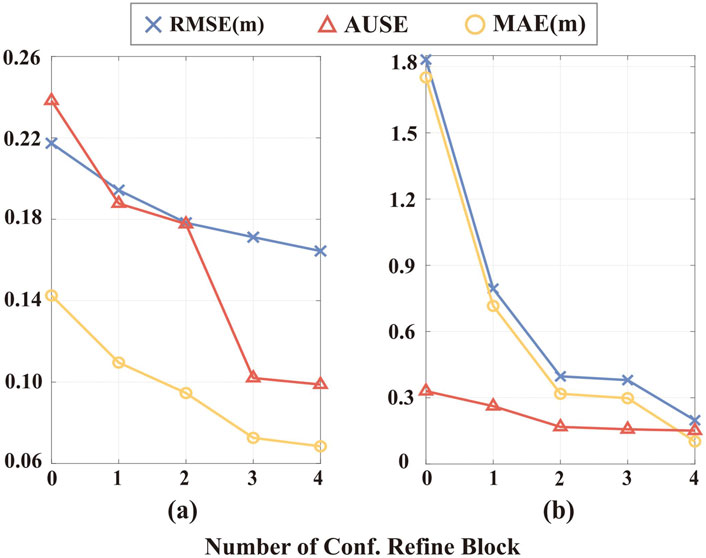
Figure 7. Accuracy of multi-resolution integration of Confidence Refinement Blocks (one per resolution). (a) Results on the NYU dataset with 200 samples. (b) Results on the VOID dataset.
5.2.2 Effect of ISM model in uncertainty estimation
IU-DC follows the same uncertainty propagation method as NCNN during the depth completion process but is distinct in its output uncertainty by integrating a map probability density function with the ISM. We validate the role of the ISM model by training a network that only utilize the confidence from the last NCNN layer for uncertainty estimation, the same method as in PNCNN. We evaluate the accuracy of uncertainty for different ranges of depth values and report the error bars in Figure 8. By incorporating the ISM model, the uncertainty estimation improves across different ranges of depth signals, aligning with our motivation discussed in Section 3.4 and confirming that our approach yields more spatially accurate uncertainty outputs. This improvement is consistent whether the input comes from random sampling or VO, validating that the ISM model is robust to the type of input signal and generalizes well across different environments.
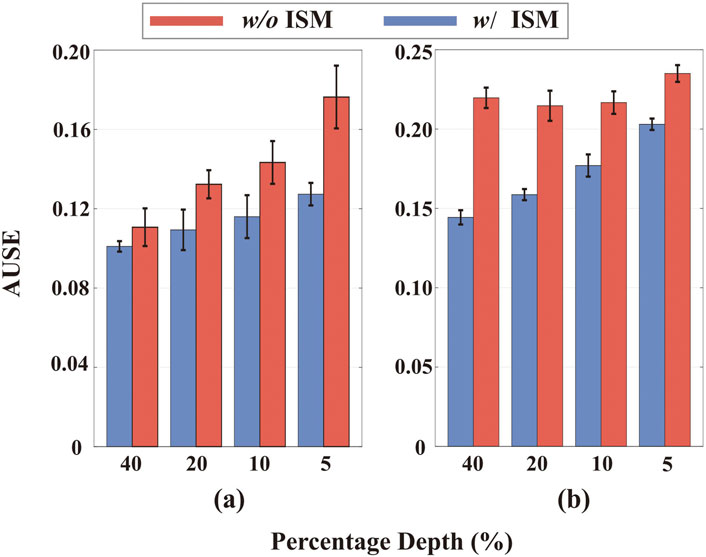
Figure 8. Accuracy of uncertainty estimation with and without the ISM model across different depth value ranges. (a) Results on the NYU dataset with 200 samples. (b) Results on the VOID dataset. The horizontal axis represents the percentage of top depth values in the depth image, e.g., 40 represents the top
Additionally, we report the depth completion accuracy in Table 3 (denoted as -w/o ISM model). The results validate that integrating the ISM model into the uncertainty estimation network not only improves uncertainty estimation but also benefits the network training, enabling it to converge to a more accurate depth estimation model.
5.2.3 Does VO uncertainty aid in depth completion?
We are also interested in whether the uncertainty estimated from VO can benefit the depth completion process. Since the VOID dataset does not provide uncertainty estimation for each input point, we adopt the uniform uncertainty estimation method from (Zhang and Ye, 2020) to compute the initial uncertainty for the input sparse depth. This estimated uncertainty is then fed into the first NCNN layer to train a baseline model. We report the results in Table 3 (denoted as w/VO conf. init.). After model convergence, the accuracy of the estimated depth significantly drops, with a large iRMSE indicating a high number of outliers. These observations suggest that directly incorporating the uncertainty from a model-based VO does not align well with the NCNN. We believe that employing a deep VO framework and training in an end-to-end manner may yield better results.
5.3 Evaluation of mapping performance
We adopt RTAB-Map (Labbé and Michaud, 2019) as the mapping module and utilize a voxel grid resolution of 0.01 m to store map for each sequence. We use either the ground truth pose (in VOID) or the pose from the V-SLAM algorithm (in our own sequence) in the mapping module to fairly assess the impact of depth estimation from different methods on mapping performance. The ground truth is generated using the ground truth depth with offline post-processing. Following (Stathoulopoulos et al., 2023), we use CloudCompare, an open-source point cloud processing software, to first align each map and then calculate the distance between the two point clouds (Mean Dist.
5.3.1 VOID
We evaluated the mapping performance of IU-DC and VI-Depth on three distinct sequences from the VOID dataset under two levels of input sparsity:
5.3.2 Long trajectory sequence in the study office
Most sequences in the VOID dataset are recorded in constrained areas with short trajectories. To evaluate our method in a more open environment with longer trajectories, which are more common scenarios encountered by mobile robots, we conducted an experiment in a large student office using a handheld Intel RealSense D435i depth camera. We obtain the pose using the open-source V-SLAM algorithm provided by RealSense and use depth images from the D435i as ground truth (same as in the VOID dataset) for both network training and inference. To generate the input for the network, we follow the method described in (Wofk et al., 2023) running the VINS-Mono feature tracker front-end (Qin et al., 2018) to obtain sparse feature locations and then sampling ground truth depth at those locations. Both the camera image and depth image have a resolution of
The visualization of the map generated by sparse VO, Droid-SLAM (dense VO) (Teed and Deng, 2021), our method, and the ground truth is presented in Figure 9. Our method achieves significant completeness with
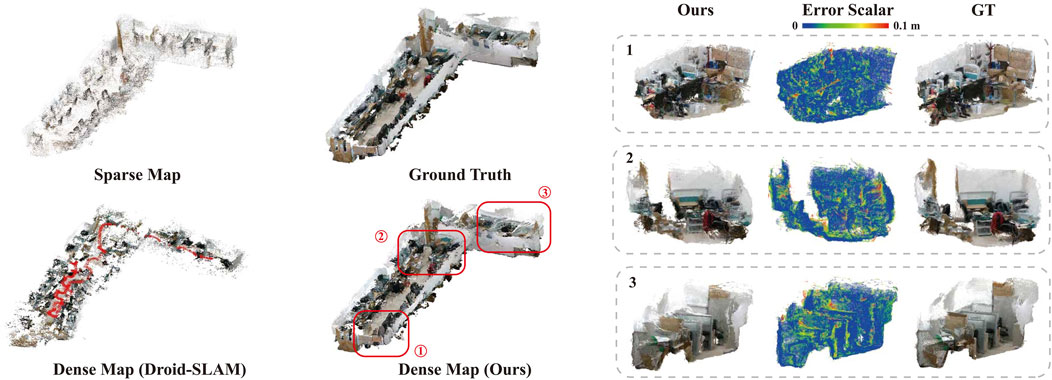
Figure 9. Evaluation of the Mapping Performance. The left part presents the maps generated by sparse VO, Droid-SLAM, and our method, while the right part shows three zoomed-in sections of our map with the associated error distribution. The Dense Map (ours) covers
5.3.3 Application in map alignment
We conducted two trajectories, each mapping half of the office with a small overlapping area, to simulate the case of a two-robot system. First, we align the two maps using the ground truth pose and then introduce random translations and rotations to simulate potential false relative poses in real-world scenarios, which is presented in Figure 10A. We align the two local maps using the transformation matrix calculated by GICP (Segal et al., 2009), utilizing the same overlapping region of the sparse map generated by VO, as shown in Figure 10B, and the dense map generated by our method, as shown in Figure 10C. The results show that directly using the sparse map results in false alignment due to the map being too sparse, with missing reliable features. In contrast, the completed map recovers most of the environmental structures, providing sufficient features for accurately aligning the two maps. Though the experiment is conducted with two robots, it can be easily extended to a multi- or even swarm-robot system.

Figure 10. Alignment of maps from two robot coordinates. (a) Initial relative pose. (b) Alignment with maps generated by VO. (c) Alignment with maps generated by our method. We use the ground truth map with a voxel resolution downsampled to 0.05 m for visualization.
6 Conclusion
In this work, we propose a novel IU-DC to complete the extremely sparse depth data from VO, enhancing spatial perception through dense mapping of the environment. We extend NCNN into an image-guided approach with a specifically designed image feature integration mechanism and an ISM-based uncertainty estimation method to encode both color and spatial features, demonstrating superior performance in both depth and uncertainty estimation. The uncertainty-aware depth output from IU-DC exhibits outstanding performance compared to other VO depth completion methods in the context of robot mapping, achieving
The major limitation of our work, similar to other VO depth completion methods, is the reliance on VO to generate an accurate initial depth estimation. A promising future direction would be to generate uncertainty estimations for both input and output depth, and further apply optimization techniques to tightly couple these uncertainties with the depth estimation from the network.
Data availability statement
The original contributions presented in the study are included in the article/Supplementary Material, further inquiries can be directed to the corresponding authors.
Author contributions
DY: Writing – original draft. XZ: Writing – review and editing. HL: Writing – review and editing. HW: Writing – review and editing. CW: Writing – review and editing. KX: Writing – review and editing. XD: Writing – review and editing.
Funding
The author(s) declare that financial support was received for the research and/or publication of this article. This work was supported by National Natural Science Foundation of China under Grant U22B2080, Grant T2121003 and Grant 52375003.
Conflict of interest
The authors declare that the research was conducted in the absence of any commercial or financial relationships that could be construed as a potential conflict of interest.
Generative AI statement
The author(s) declare that no Generative AI was used in the creation of this manuscript.
Any alternative text (alt text) provided alongside figures in this article has been generated by Frontiers with the support of artificial intelligence and reasonable efforts have been made to ensure accuracy, including review by the authors wherever possible. If you identify any issues, please contact us.
Publisher’s note
All claims expressed in this article are solely those of the authors and do not necessarily represent those of their affiliated organizations, or those of the publisher, the editors and the reviewers. Any product that may be evaluated in this article, or claim that may be made by its manufacturer, is not guaranteed or endorsed by the publisher.
Supplementary material
The Supplementary Material for this article can be found online at: https://www.frontiersin.org/articles/10.3389/frobt.2025.1644230/full#supplementary-material
References
Agha-Mohammadi, A.-A., Heiden, E., Hausman, K., and Sukhatme, G. (2019). Confidence-rich grid mapping. Int. J. Robotics Res. 38 (12-13), 1352–1374. doi:10.1177/0278364919839762
Aguiar, A. S., Neves dos Santos, F., Sobreira, H., Boaventura-Cunha, J., and Sousa, A. J. (2022). Localization and mapping on agriculture based on point-feature extraction and semiplanes segmentation from 3d lidar data. Front. Robotics AI 9, 832165. doi:10.3389/frobt.2022.832165
Araya-Martinez, J. M., Matthiesen, V. S., Bøgh, S., Lambrecht, J., and de Figueiredo, R. P. (2025). A fast monocular 6d pose estimation method for textureless objects based on perceptual hashing and template matching. Front. Robotics AI 11, 1424036. doi:10.3389/frobt.2024.1424036
Chen, D., Huang, T., Song, Z., Deng, S., and Jia, T. (2023). “Agg-net: attention guided gated-convolutional network for depth image completion,” in Proceedings of the IEEE/CVF international conference on computer vision, 8853–8862.
Eldesokey, A., Felsberg, M., and Khan, F. S. (2019). Confidence propagation through cnns for guided sparse depth regression. IEEE Trans. pattern analysis Mach. Intell. 42 (10), 2423–2436. doi:10.1109/tpami.2019.2929170
Eldesokey, A., Felsberg, M., Holmquist, K., and Persson, M. (2020). “Uncertainty-aware cnns for depth completion: uncertainty from beginning to end,” in Proceedings of the IEEE/CVF conference on computer vision and pattern recognition, 12 014–12 023.
Fei, X., Wong, A., and Soatto, S. (2019). Geo-supervised visual depth prediction. IEEE Robotics Automation Lett. 4 (2), 1661–1668. doi:10.1109/lra.2019.2896963
Gustafsson, F. K., Danelljan, M., and Schon, T. B. (2020). “Evaluating scalable bayesian deep learning methods for robust computer vision,” in Proceedings of the IEEE/CVF conference on computer vision and pattern recognition workshops, 318–319.
Hu, J., Bao, C., Ozay, M., Fan, C., Gao, Q., Liu, H., et al. (2022). Deep depth completion from extremely sparse data: a survey. IEEE Trans. Pattern Analysis Mach. Intell. 45 (7), 8244–8264. doi:10.1109/TPAMI.2022.3229090
Ilg, E., Cicek, O., Galesso, S., Klein, A., Makansi, O., Hutter, F., et al. (2018). “Uncertainty estimates and multi-hypotheses networks for optical flow,” in Proceedings of the European conference on computer vision (ECCV), 652–667.
Kendall, A., and Gal, Y. (2017). What uncertainties do we need in bayesian deep learning for computer vision? Adv. neural Inf. Process. Syst. 30.
Knutsson, H., and Westin, C.-F. (1993). “Normalized and differential convolution,” in Proceedings of IEEE conference on computer vision and pattern recognition (IEEE), 515–523.
Labbé, M., and Michaud, F. (2019). Rtab-map as an open-source lidar and visual simultaneous localization and mapping library for large-scale and long-term online operation. J. field robotics 36 (2), 416–446. doi:10.1002/rob.21831
Labbé, M., and Michaud, F. (2022). Multi-session visual slam for illumination-invariant re-localization in indoor environments. Front. Robotics AI 9, 801886. doi:10.3389/frobt.2022.801886
Liu, T. Y., Agrawal, P., Chen, A., Hong, B.-W., and Wong, A. (2022). “Monitored distillation for positive congruent depth completion,” in European conference on computer vision (Springer), 35–53.
Liu, L., Song, X., Sun, J., Lyu, X., Li, L., Liu, Y., et al. (2023). Mff-net: towards efficient monocular depth completion with multi-modal feature fusion. IEEE Robotics Automation Lett. 8 (2), 920–927. doi:10.1109/lra.2023.3234776
Loop, C., Cai, Q., Orts-Escolano, S., and Chou, P. A. (2016). “A closed-form bayesian fusion equation using occupancy probabilities,” in 2016 fourth international conference on 3D vision (3DV) (IEEE), 380–388.
Ma, F., and Karaman, S. (2018). “Sparse-to-dense: depth prediction from sparse depth samples and a single image,” in 2018 IEEE international conference on robotics and automation (ICRA) (IEEE), 4796–4803.
Malakouti-Khah, H., Sadeghzadeh-Nokhodberiz, N., and Montazeri, A. (2024). Simultaneous localization and mapping in a multi-robot system in a dynamic environment with unknown initial correspondence. Front. Robotics AI 10, 1291672. doi:10.3389/frobt.2023.1291672
Mathew, A., Magerand, L., Trucco, E., and Manfredi, L. (2023). Self-supervised monocular depth estimation for high field of view colonoscopy cameras. Front. Robotics AI 10, 1212525. doi:10.3389/frobt.2023.1212525
Merrill, N., Geneva, P., and Huang, G. (2021). “Robust monocular visual-inertial depth completion for embedded systems,” in 2021 IEEE international conference on robotics and automation (ICRA) (IEEE), 5713–5719.
Popović, M., Thomas, F., Papatheodorou, S., Funk, N., Vidal-Calleja, T., and Leutenegger, S. (2021). Volumetric occupancy mapping with probabilistic depth completion for robotic navigation. IEEE Robotics Automation Lett. 6 (3), 5072–5079. doi:10.1109/lra.2021.3070308
Qin, T., Li, P., and Shen, S. (2018). Vins-mono: a robust and versatile monocular visual-inertial state estimator. IEEE Trans. Robotics 34 (4), 1004–1020. doi:10.1109/tro.2018.2853729
Qu, C., Liu, W., and Taylor, C. J. (2021). “Bayesian deep basis fitting for depth completion with uncertainty,” in Proceedings of the IEEE/CVF international conference on computer vision, 16 147–16 157.
Ronneberger, O., Fischer, P., and Brox, T. (2015). “U-net: convolutional networks for biomedical image segmentation,” in Medical image computing and computer-assisted intervention–MICCAI 2015: 18Th international conference, munich, Germany, October 5-9, 2015, proceedings, part III 18 (Springer), 234–241.
Segal, A., Haehnel, D., and Thrun, S. (2009). The Robotics: Science and Systems (RSS). Seattle, Washington, USA: University of Washington.
Silberman, N., Hoiem, D., Kohli, P., and Fergus, R. (2012). “Indoor segmentation and support inference from rgbd images,” in Computer Vision–ECCV 2012: 12Th European conference on computer vision, florence, Italy, October 7-13, 2012, proceedings, part V 12 (Springer), 746–760.
Stathoulopoulos, N., Koval, A., Agha-mohammadi, A.-a., and Nikolakopoulos, G. (2023). “Frame: fast and robust autonomous 3d point cloud map-merging for egocentric multi-robot exploration,” in 2023 IEEE International Conference on Robotics and Automation ICRA, 3483–3489.
Tao, Y., Popović, M., Wang, Y., Digumarti, S. T., Chebrolu, N., and Fallon, M. (2022). “3d lidar reconstruction with probabilistic depth completion for robotic navigation,” in 2022 IEEE/RSJ international conference on intelligent robots and systems (IROS) (IEEE), 5339–5346.
Teed, Z., and Deng, J. (2021). Droid-slam: deep visual slam for monocular, stereo, and rgb-d cameras. Adv. neural Inf. Process. Syst. 34, 16 558–16 569.
Teixeira, L., Oswald, M. R., Pollefeys, M., and Chli, M. (2020). Aerial single-view depth completion with image-guided uncertainty estimation. IEEE Robotics Automation Lett. 5 (2), 1055–1062. doi:10.1109/lra.2020.2967296
Uhrig, J., Schneider, N., Schneider, L., Franke, U., Brox, T., and Geiger, A. (2017). “Sparsity invariant cnns,” in International conference on 3D vision (3DV).
Wang, M., Ding, Y., Liu, Y., Qin, Y., Li, R., and Tang, Z. (2025). Mixssc: forward-backward mixture for vision-based 3d semantic scene completion. IEEE Trans. Circuits Syst. Video Technol. 35, 5684–5696. doi:10.1109/tcsvt.2025.3527235
Wofk, D., Ranftl, R., Müller, M., and Koltun, V. (2023). “Monocular visual-inertial depth estimation,” in 2023 IEEE international conference on robotics and automation (ICRA) (IEEE), 6095–6101.
Wong, A., Fei, X., Tsuei, S., and Soatto, S. (2020). Unsupervised depth completion from visual inertial odometry. IEEE Robotics Automation Lett. 5 (2), 1899–1906. doi:10.1109/lra.2020.2969938
Woo, S., Park, J., Lee, J.-Y., and Kweon, I. S. (2018). “Cbam: convolutional block attention module,” in Proceedings of the European conference on computer vision (ECCV), 3–19.
Yu, J., Lin, Z., Yang, J., Shen, X., Lu, X., and Huang, T. S. (2019). “Free-form image inpainting with gated convolution,” in Proceedings of the IEEE/CVF international conference on computer vision, 4471–4480.
Keywords: mapping, deep learning for visual perception, visual odometry, depth completion, uncertainty estimation
Citation: Yang D, Zhang X, Liu H, Wu H, Wang C, Xu K and Ding X (2025) Dense mapping from sparse visual odometry: a lightweight uncertainty-guaranteed depth completion method. Front. Robot. AI 12:1644230. doi: 10.3389/frobt.2025.1644230
Received: 10 June 2025; Accepted: 08 August 2025;
Published: 22 September 2025.
Edited by:
Li Li, Wuhan University, ChinaReviewed by:
Long Cheng, Chinese Academy of Sciences (CAS), ChinaHanyun Wang, PLA Strategic Support Force Information Engineering University, China
Copyright © 2025 Yang, Zhang, Liu, Wu, Wang, Xu and Ding. This is an open-access article distributed under the terms of the Creative Commons Attribution License (CC BY). The use, distribution or reproduction in other forums is permitted, provided the original author(s) and the copyright owner(s) are credited and that the original publication in this journal is cited, in accordance with accepted academic practice. No use, distribution or reproduction is permitted which does not comply with these terms.
*Correspondence: Chengcai Wang, Y2Nfd2FuZ0BidWFhLmVkdS5jbg==; Kun Xu, eGswMDdAYnVhYS5lZHUuY24=
 Daolong Yang
Daolong Yang Xudong Zhang
Xudong Zhang Kun Xu
Kun Xu Xilun Ding
Xilun Ding